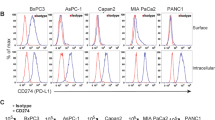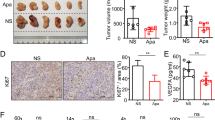Abstract
Suicide gene therapy using the herpes simplex virus thymidine kinase/ganciclovir (HSV-tk/GCV) system combined with monocyte chemoattractant protein-1 (MCP-1) provides significant antitumor efficacy. The current study was designed to evaluate the antitumor immunity of a newly developed membrane-bound form of MCP-1 (mMCP-1) in an immunocompetent mouse model of hepatocellular carcinoma (HCC). A recombinant adenovirus vector (rAd) harboring the human MCP-1 gene and the membrane-spanning domain of the CX3CL1 gene was used. Large amounts of MCP-1 protein were expressed and accumulated on the tumor cell surface. The growth of subcutaneous tumors was markedly suppressed when tumors were treated with mMCP-1, as compared with soluble MCP-1, in combination with the HSV-tk/GCV system (P<0.01). The numbers of Mac-1-, CD4- and CD8a-positive cells were significantly higher in tumor tissues (P<0.05), and tumor necrosis factor (TNF) mRNA expression levels with mMCP-1 were almost five-fold higher than those with soluble MCP-1. These results indicate that the delivery of the mMCP-1 gene greatly enhanced antitumor effects following the apoptotic stimuli by promoting the recruitment and activation of macrophages and T lymphocytes, suggesting a novel strategy of immune-based gene therapy in the treatment of patients with HCC.
This is a preview of subscription content, access via your institution
Access options
Subscribe to this journal
Receive 12 print issues and online access
$259.00 per year
only $21.58 per issue
Buy this article
- Purchase on Springer Link
- Instant access to full article PDF
Prices may be subject to local taxes which are calculated during checkout





Similar content being viewed by others
References
Venook AP . Treatment of hepatocellular carcinoma: too many options? J Clin Oncol 1994; 12: 1323–1334.
Trinchet JC, Beaugrand M . Treatment of hepatocellular carcinoma in patients with cirrhosis. J Hepatol 1997; 27: 756–765.
Bruix J . Treatment of hepatocellular carcinoma. Hepatology 1997; 25: 259–262.
Sakai Y, Kaneko S, Nakamoto Y, Kagaya T, Mukaida N, Kobayashi K . Enhanced anti-tumor effects of herpes simplex virus thymidine kinase/ganciclovir system by codelivering monocyte chemoattractant protein-1 in hepatocellular carcinoma. Cancer Gene Ther 2001; 8: 695–704.
Tsuchiyama T, Kaneko S, Nakamoto Y, Sakai Y, Honda M, Mukaida N et al. Enhanced antitumor effects of a bicistronic adenovirus vector expressing both herpes simplex virus thymidine kinase and monocyte chemoattractant protein-1 against hepatocellular carcinoma. Cancer Gene Ther 2003; 10: 260–269.
Kagaya T, Nakamoto Y, Sakai Y, Tsuchiyama T, Yagita H, Mukaida N et al. Monocyte chemoattractant protein-1 gene delivery enhances antitumor effects of herpes simplex virus thymidine kinase/ganciclovir system in a model of colon cancer. Cancer Gene Ther 2006; 13: 357–366.
Freund CT, Sutton MA, Dang T, Contant CF, Rowley D, Lerner SP . Adenovirus-mediated combination suicide and cytokine gene therapy for bladder cancer. Anticancer Res 2000; 20: 1359–1365.
Kim YS . Tumor therapy applying membrane-bound form of cytokines. Immune Netw 2009; 9: 158–168.
Sato Y, Tanaka K, Lee G, Kanegae Y, Sakai Y, Kaneko S et al. Enhanced and specific gene expression via tissue-specific production of Cre recombinase using adenovirus vector. Biochem Biophys Res Commun 1998; 244: 455–462.
Kanegae Y, Makimura M, Saito I . A simple and efficient method for purification of infectious recombinant adenovirus. Jpn J Med Sci Biol 1994; 47: 157–166.
Ko Y, Mukaida N, Panyutich A, Voitenok NN, Matsushima K, Kawai T et al. A sensitive enzyme-linked immunosorbent assay for human interleukin-8. J Immunol Methods 1992; 149: 227–235.
Nakano Y, Kasahara T, Mukaida N, Ko YC, Nakano M, Matsushima K . Protection against lethal bacterial infection in mice by monocyte-chemotactic and -activating factor. Infect Immun 1994; 62: 377–383.
Ji J, Li J, Holmes LM, Burgin KE, Yu X, Wagner TE et al. Glycoinositol phospholipid-anchored interleukin 2 but not secreted interleukin 2 inhibits melanoma tumor growth in mice. Mol Cancer Ther 2002; 1: 1019–1024.
Lu P, Li L, Liu G, van Rooijen N, Mukaida N, Zhang X . Opposite roles of CCR2 and CX3CR1 macrophages in alkali-induced corneal neovascularization. Cornea 2009; 28: 562–569.
Sadahira Y, Yasuda T, Yoshino T, Manabe T, Takeishi T, Kobayashi Y et al. Impaired splenic erythropoiesis in phlebotomized mice injected with CL2MDP-liposome: an experimental model for studying the role of stromal macrophages in erythropoiesis. J Leukoc Biol 2000; 68: 464–470.
Tsuchiyama T, Nakamoto Y, Sakai Y, Mukaida N, Kaneko S . Optimal amount of monocyte chemoattractant protein-1 enhances antitumor effects of suicide gene therapy against hepatocellular carcinoma by M1 macrophage activation. Cancer Sci 2008; 99: 2075–2082.
Tsuchiyama T, Nakamoto Y, Sakai Y, Marukawa Y, Kitahara M, Mukaida N et al. Prolonged, NK cell-mediated antitumor effects of suicide gene therapy combined with monocyte chemoattractant protein-1 against hepatocellular carcinoma. J Immunol 2007; 178: 574–583.
Kakinoki K, Nakamoto Y, Kagaya T, Tsuchiyama T, Sakai Y, Nakahama T et al. Prevention of intrahepatic metastasis of liver cancer by suicide gene therapy and chemokine ligand 2/monocyte chemoattractant protein-1 delivery in mice. J Gene Med 2010; 12: 1002–1013.
Chang MR, Lee WH, Choi JW, Park SO, Paik SG, Kim YS . Antitumor immunity induced by tumor cells engineered to express a membrane-bound form of IL-2. Exp Mol Med 2005; 37: 240–249.
Ji J, Li J, Holmes LM, Burgin KE, Yu X, Wagner TE et al. Synergistic anti-tumor effect of glycosylphosphatidylinositol-anchored IL-2 and IL-12. J Gene Med 2004; 6: 777–785.
Nagarajan S, Selvaraj P . Glycolipid-anchored IL-12 expressed on tumor cell surface induces antitumor immune response. Cancer Res 2002; 62: 2869–2874.
Tang L, Hu HD, Hu P, Lan YH, Peng ML, Chen M et al. Gene therapy with CX3CL1/Fractalkine induces antitumor immunity to regress effectively mouse hepatocellular carcinoma. Gene Ther 2007; 14: 1226–1234.
Rieger R, Whitacre D, Cantwell MJ, Prussak C, Kipps TJ . Chimeric form of tumor necrosis factor-alpha has enhanced surface expression and antitumor activity. Cancer Gene Ther 2009; 16: 53–64.
Nooijen PT, Eggermont AM, Verbeek MM, Schalkwijk L, Buurman WA, de Waal RM et al. Transient induction of E-selectin expression following TNF alpha-based isolated limb perfusion in melanoma and sarcoma patients is not tumor specific. J Immunother Emphasis Tumor Immunol 1996; 19: 33–44.
Yang L, Froio RM, Sciuto TE, Dvorak AM, Alon R, Luscinskas FW . ICAM-1 regulates neutrophil adhesion and transcellular migration of TNF-alpha-activated vascular endothelium under flow. Blood 2005; 106: 584–592.
Vanhee D, Delneste Y, Lassalle P, Gosset P, Joseph M, Tonnel AB . Modulation of endothelial cell adhesion molecule expression in a situation of chronic inflammatory stimulation. Cell Immunol 1994; 155: 446–456.
VandenBerg E, Reid MD, Edwards JD, Davis HW . The role of the cytoskeleton in cellular adhesion molecule expression in tumor necrosis factor-stimulated endothelial cells. J Cell Biochem 2004; 91: 926–937.
Huang S, Singh RK, Xie K, Gutman M, Berry KK, Bucana CD et al. Expression of the JE/MCP-1 gene suppresses metastatic potential in murine colon carcinoma cells. Cancer Immunol Immunother 1994; 39: 231–238.
Rollins BJ, Sunday ME . Suppression of tumor formation in vivo by expression of the JE gene in malignant cells. Mol Cell Biol 1991; 11: 3125–3131.
Nokihara H, Yanagawa H, Nishioka Y, Yano S, Mukaida N, Matsushima K et al. Natural killer cell-dependent suppression of systemic spread of human lung adenocarcinoma cells by monocyte chemoattractant protein-1 gene transfection in severe combined immunodeficient mice. Cancer Res 2000; 60: 7002–7007.
Nakashima E, Mukaida N, Kubota Y, Kuno K, Yasumoto K, Ichimura F et al. Human MCAF gene transfer enhances the metastatic capacity of a mouse cachectic adenocarcinoma cell line in vivo. Pharm Res 1995; 12: 1598–1604.
Ueno T, Toi M, Saji H, Muta M, Bando H, Kuroi K et al. Significance of macrophage chemoattractant protein-1 in macrophage recruitment, angiogenesis, and survival in human breast cancer. Clin Cancer Res 2000; 6: 3282–3289.
Nesbit M, Schaider H, Miller TH, Herlyn M . Low-level monocyte chemoattractant protein-1 stimulation of monocytes leads to tumor formation in nontumorigenic melanoma cells. J Immunol 2001; 166: 6483–6490.
Curley SA . Radiofrequency ablation of malignant liver tumors. Ann Surg Oncol 2003; 10: 338–347.
Tung-Ping Poon R, Fan ST, Wong J . Risk factors, prevention, and management of postoperative recurrence after resection of hepatocellular carcinoma. Ann Surg 2000; 232: 10–24.
Marshall E . Gene therapy death prompts review of adenovirus vector. Science 1999; 286: 2244–2245.
Acknowledgements
We thank Mariko Katsuda for assistance with histopathological analysis and immunohistochemistry, and Maki Kawamura and Chiharu Minami for providing animal care.
Author information
Authors and Affiliations
Corresponding author
Ethics declarations
Competing interests
The authors declare no conflict of interest.
Rights and permissions
About this article
Cite this article
Marukawa, Y., Nakamoto, Y., Kakinoki, K. et al. Membrane-bound form of monocyte chemoattractant protein-1 enhances antitumor effects of suicide gene therapy in a model of hepatocellular carcinoma. Cancer Gene Ther 19, 312–319 (2012). https://doi.org/10.1038/cgt.2012.3
Received:
Revised:
Accepted:
Published:
Issue Date:
DOI: https://doi.org/10.1038/cgt.2012.3



